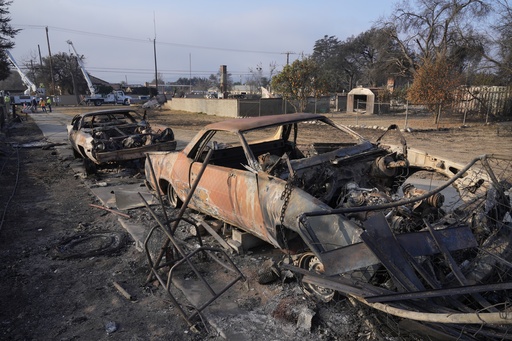LOS ANGELES — A California utility reported on Thursday that its equipment could potentially have ignited a small wildfire in Los Angeles, coinciding with two other major fires in the region that resulted in the loss of at least 29 lives and the destruction of thousands of residences.
Southern California Edison (SCE) communicated that the Los Angeles Fire Department is currently examining the origins of the Hurst Fire. Preliminary indications suggest that the utility’s equipment might be connected to the fire’s ignition, although this particular incident did not result in any structural damage or fatalities. In a required documentation sent to state utility regulators, SCE stated that, “absent additional evidence, SCE believes its equipment may be associated with ignition of the Hurst Fire.”
In another report, the utility disclosed that it is investigating the possibility of an idle transmission line that may have become energized and sparked the deadly Eaton Fire, which severely affected Altadena on January 7. However, SCE claims that there is currently no proof to confirm that its equipment caused this particular fire.
Last month, the utility acknowledged that various fire agencies are probing into whether its equipment might have played a role in igniting the Hurst Fire, which burned approximately 1.25 square miles (3.2 square km) near the Sylmar district of Los Angeles.
SCE stated that it is fully cooperating with investigators regarding these incidents. Concerning the Eaton Fire, the utility is analyzing a video that allegedly depicts “flashes” of electrical arcing from a tower near the fire’s origin. Although preliminary investigations have found no signs of arcing, some damage was identified on connected equipment.
The report from SCE clarified, “We do not know when this damage occurred, and a comparison of photographs taken before and after the fire is currently underway.” Several lawsuits have been filed against SCE based on the mentioned video, alleging that the utility’s equipment initiated the Eaton Fire. Nonetheless, SCE argues that it is premature to draw any definitive conclusions regarding this claim.
In a news release announcing the documentation, the utility argued, “SCE has not identified typical or obvious indications that would support this association, such as broken conductors, fresh arc marks in the preliminary origin area, or evidence of faults on the energized lines running through that area.”
The Eaton Fire, which claimed at least 17 lives, was reported to be fully contained last week. Similarly, full containment was achieved for the Palisades Fire, the largest of the blazes, which resulted in the destruction of thousands of homes and 12 confirmed fatalities.
___
This article has been clarified to indicate that Southern California Edison has stated that its equipment may have caused the Hurst Fire, not that it is likely to have done so.



